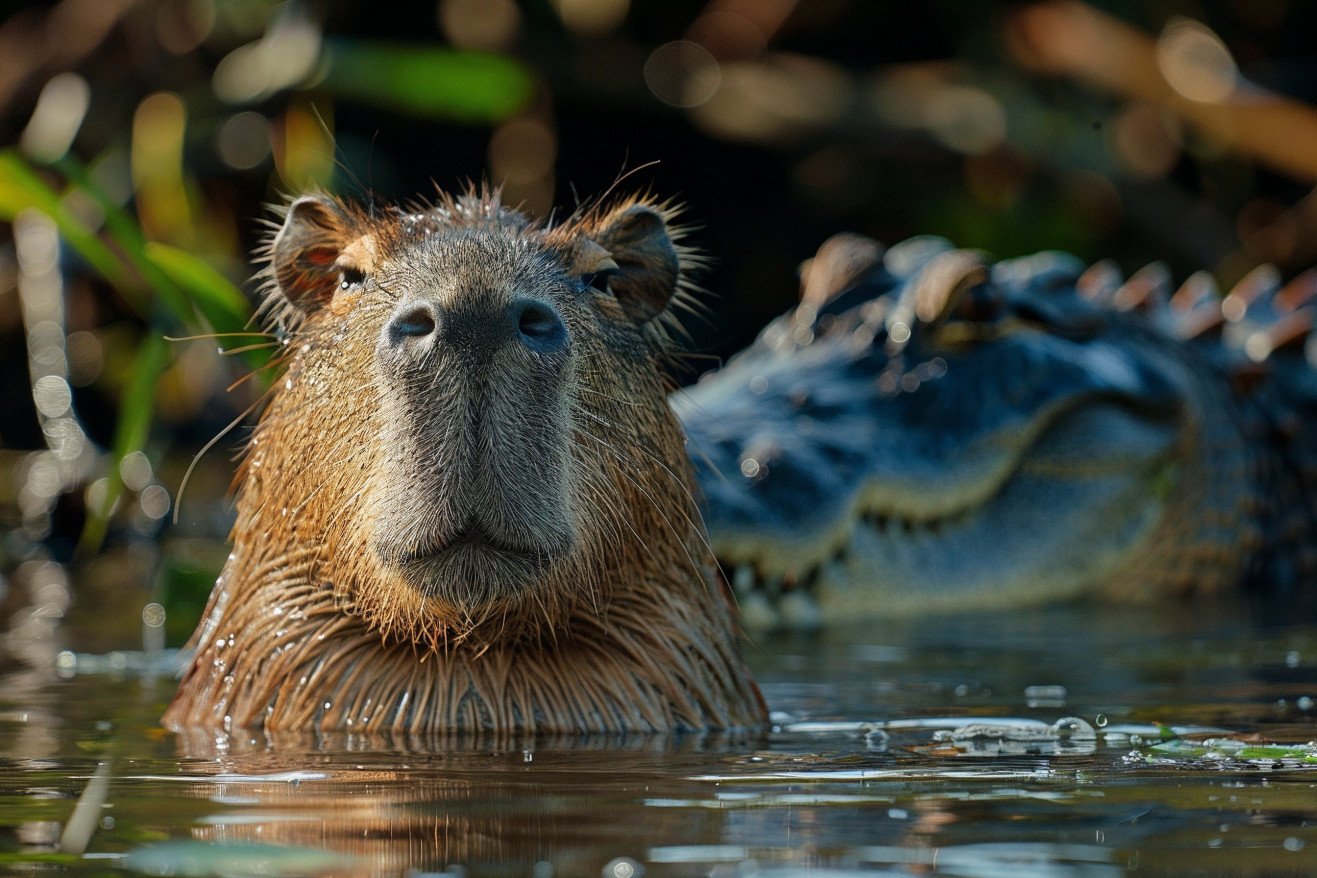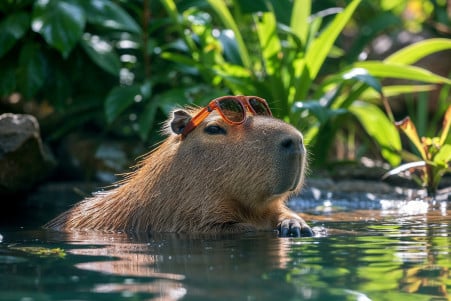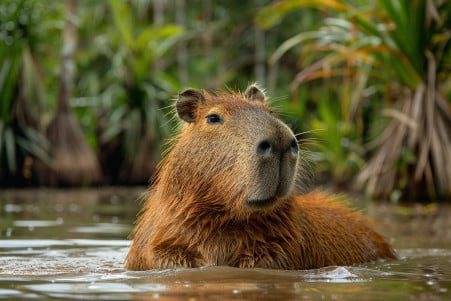Do Crocodiles Eat Capybaras? Exploring Predator-Prey Interactions
7 March 2024 • Updated 7 March 2024

In the complex world of freshwater ecosystems, capybaras are one of the many animals that make up the food chain. So, do crocodiles eat capybaras? Crocodiles can and do eat capybaras because they are opportunistic predators that eat a wide range of prey.
In the South American environments where they live, crocodiles are known to eat capybaras, especially young or vulnerable ones. However, the two species are known to coexist and are often found in close proximity to one another.
To better understand the predator-prey relationship between crocodiles and capybaras, we will look at ecological and behavioral research, with insights from zoology and wildlife biology. This will involve studies of crocodile feeding habits, capybara habitat selection, and the survival strategies of both species. By combining the results of field research and scholarly articles, we hope to build a complete picture of these interactions in their natural habitats.
Do crocodiles eat capybaras?
The Capybara: South America’s Giant Rodent
Capybaras are the world’s largest rodents, and they are notable for their large size, which is similar to that of a pig.
They can weigh between 35 and 65 kg (77 to 143 pounds) when they are fully grown and have a coat of short, bristly hair that is well-suited to their semi-aquatic lifestyle.
They also have webbed feet and their eyes, ears, and nostrils are all located on top of their heads, which allows them to keep an eye out for danger when they are in the water, according to Discover Wildlife. Capybaras are native to South America and are found in areas near water, such as marshes and swamps.
Capybaras are herbivores that eat a diet that is primarily made up of grasses and aquatic plants. They also exhibit a number of interesting behaviors, including cecotrophy, which is the practice of eating their own feces to ensure that they have fully absorbed all of the nutrients from their food, which helps them ensure that they are as healthy as possible.
Capybaras live in groups that can include anywhere from 5 to 100 individuals. They use a variety of vocalizations to communicate with one another, including low-pitched barks that they use to warn their group of danger. This indicates that they have a complex system of communication that they use to warn their group of the presence of predators, according to A-Z Animals.
Capybaras are strong swimmers that can stay underwater for up to five minutes, and they use this ability to evade predators that live on land.
This is particularly important when they are dealing with predators like caimans and crocodiles, which are often found in the same areas as capybaras.
The group’s ability to warn one another of danger, combined with their ability to swim, are important factors in their ability to survive in the presence of these predators.
How Crocodiles Hunt
Crocodiles are apex predators and are known for their stealth and cunning hunting techniques. They use ambush hunting, where they wait for the perfect moment to quickly and often lethally attack their prey. Their prey can range from small fish to large mammals, according to Basic Biology. This adaptability in the types of animals they hunt and their ability to influence a variety of ecosystems shows how adaptable they are as a species.
Incredibly, crocodiles also show complex social hunting behaviors and are not solitary hunters. A study in Ethology Ecology and Evolution found that crocodiles can work together and even take on different roles based on their size and strength to catch their prey.
This complexity shows that crocodiles may be able to change their hunting techniques to catch capybaras, especially since capybaras often live in large groups that are on the lookout for danger in the water where crocodiles are hunting.
In South American wetlands, the habitats of crocodiles and capybaras overlap, creating the potential for crocodiles to prey on capybaras. Crocodiles’ adaptability allows them to take advantage of a variety of environmental situations and use the waterways that capybaras live near as hunting grounds. Because of the crocodile’s hunting prowess, it’s clear that capybaras need to have strong defense mechanisms in place to protect themselves from these powerful reptiles.
Capybara Defense Mechanisms: How Capybaras Avoid Predation
Capybaras have a number of ways to protect themselves from their predators, which include crocodiles. In addition to their sharp teeth, which are well-suited for grazing, capybaras can also use their teeth to defend themselves when they feel threatened. PawsGeek explains that while capybaras are not aggressive animals, they will use their teeth to bite their predators in self-defense.
Capybaras’ speed and agility are also important for their survival. Capybaras can run at speeds of up to 22 miles per hour, which is faster than many of the animals that prey on them.
They are also semi-aquatic, which means they can escape to the water when they are being chased. They can hold their breath for up to five minutes, which means they can dive and hide from their predators.
World Land Trust explains that capybaras’ eyes, nostrils, and ears are positioned on the top of their heads, which allows them to keep an eye out for predators while they are in the water.
Capybaras’ social groups are also important for their survival. During the dry season, capybara groups can grow to include as many as 100 individuals. This means that there are many capybaras that can keep an eye out for predators, and when they see a predator, they can warn the other members of their group with a series of different calls. This means that the capybaras can work together to avoid being eaten by their predators.
Capybaras’ vigilance, sense of smell, and hearing all help them avoid being eaten by their predators. This is because they can smell and hear their predators before they are attacked, which means they can take action to avoid being eaten.
Capybara and Crocodile Populations: Coexistence and Challenges
Capybaras (Hydrochoerus hydrochaeris) have complex social systems that change with population density, and this has a big impact on their survival and interactions with predators.
A paper in the Journal of Mammalogy by Elizabeth R. Congdon shows that as capybara population density increases, group sizes increase, and this could mean that larger groups are better able to defend themselves against predators like crocodiles. The spatial distribution of water sources also impacts dispersal patterns, which are important for genetic and social reasons.
Crocodiles often live in the same areas as capybaras, especially in places like the Llanos of Venezuela and the Pantanal wetlands of western Brazil. A report from the International Environment Library Consortium notes that the distribution of capybaras across a large part of South America is similar to the distribution of several crocodile species. This increases the chances of predation, and this is affected by things like changes in the environment and human activities.
A paper in the Journal of Mammalogy by Carlos A. Vettorazzi shows that human-induced landscape changes, like deforestation and the expansion of agriculture, impact capybara distribution. These changes can also impact crocodile habitats, which could lead to more encounters.
It’s important to work to conserve both species’ population dynamics and natural habitats to control their interactions and reduce human-wildlife conflict. As we continue to learn about the balance of these ecosystems, it’s clear that preserving natural ecosystems is essential to the coexistence of capybaras and crocodiles.
Crocodiles’ Importance in Ecosystem Balance and Conservation Efforts
Crocodiles are powerful apex predators that are essential to maintaining the balance of the ecosystems they inhabit. By preying on a variety of animals, including capybaras, crocodiles help to control the populations of their prey and keep the ecosystems they live in diverse and productive.
WorldAtlas points out that crocodiles help to maintain the diversity of wetlands by preying on fish that are sick, which prevents the spread of disease and allows healthy fish populations to thrive.
Conservationists have to ensure that crocodile populations remain stable so that the ecosystems they live in can continue to thrive. As World Animal Protection explains, crocodiles help to keep waterways clean, which is important for many other species. However, many crocodile species are at risk due to factors like habitat destruction, climate change, and hunting, which means that conservation efforts need to continue.
The relationship between crocodile conservation and predator-prey dynamics is complex. On the one hand, as apex predators, well-managed crocodile populations can help to keep the populations of certain prey species, like capybaras, in check. On the other hand, declining crocodile populations can lead to imbalances in ecosystems. As a paper on ResearchGate explains, it’s important to make sure that conservation efforts are based on evidence so that crocodiles can be conserved effectively.
To this end, it’s important to consider larger ecological and conservation issues. By doing so, it’s possible to ensure that the interactions between crocodiles and capybaras are balanced and that the ecosystems they live in remain healthy and diverse.
What This Can Teach Us About the Crocodile–Capybara Relationship
So, what have we learned from our deep dive into the world of crocodiles and capybaras? The predator-prey relationship between these two animals is as interesting as it is complicated.
Crocodiles are opportunistic predators and do prey on capybaras in the right circumstances in their shared South American environment. However, the relationship is far from one-sided. Capybaras have a number of defenses, including group vigilance and their own aquatic abilities, that allow them to live with and often escape these powerful predators.
This kind of relationship is important to understand in the context of the environment. It shows how important it is for ecosystems to maintain their balance, with every animal species contributing to the health of the environment. The predator-prey relationship is also a great example of how animals can adapt and change to their environments.
While future research could certainly look at the relationship between crocodiles and capybaras in more detail, including how often crocodiles are able to successfully prey on capybaras and how environmental changes can impact the relationship, this research would help us to better understand the relationship and help to ensure that both crocodiles and capybaras can continue to live in their shared environment for years to come.


